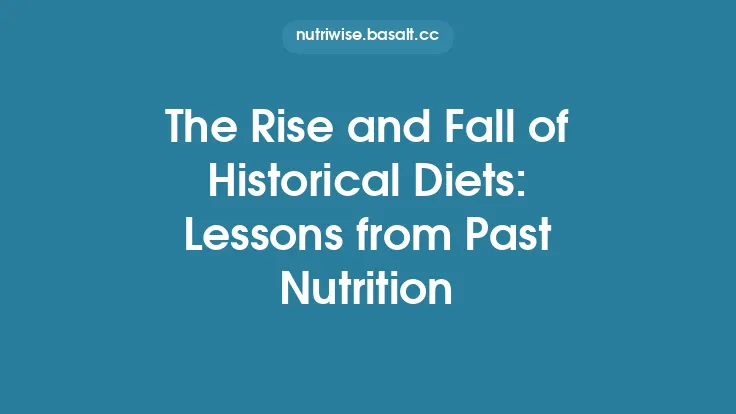The morning meal has always been more than a simple refueling ritual; it reflects the social, economic, and technological currents of its time. From the humble porridge that warmed early American settlers to the nutritionally engineered bowls of today, breakfast has continuously adapted to changing resources, labor patterns, and scientific insights. Tracing this evolution reveals how cultural values, agricultural developments, and advances in food processing have shaped what people put on their plates each day.
Colonial Beginnings: Porridge, Bread, and Survival
In the 17th and 18th centuries, breakfast in the American colonies was primarily a pragmatic affair. Settlers relied on locally available staples:
- Porridge and Gruel – Made from coarse grains such as oats, cornmeal, or rye, these hot cereals were boiled in water or milk. The consistency could range from thin gruel to thick, spoon‑laden porridge, depending on the grain-to‑liquid ratio.
- Hardtack and Sourdough Bread – Long‑lasting, low‑moisture breads were baked in communal ovens. Sourdough, in particular, provided a modest source of lactic‑acid bacteria, which modestly improved gut health.
- Preserved Meats and Fish – Salt‑cured pork, jerky, or smoked fish were sliced thin and eaten with bread or porridge, adding protein and essential fats.
- Seasonal Fruit and Berries – When in season, wild berries, apples, or pumpkins were added to porridge or eaten raw, contributing vitamins and fiber.
The nutritional profile of these meals was dictated by necessity: high‑energy carbohydrates for labor‑intense days, modest protein, and limited fat. The lack of refrigeration meant that perishable items were scarce, reinforcing reliance on dry, shelf‑stable foods.
The Early 19th‑Century Shift: Coffee, Tea, and the Rise of the “Continental” Breakfast
As trade routes expanded and urban centers grew, new beverages and foods entered the breakfast repertoire:
- Coffee and Tea – Imported from the Caribbean, South America, and Asia, these stimulants replaced the earlier reliance on ale or weak cider. Their caffeine content provided a quick mental boost for workers and merchants.
- Eggs and Bacon – Improved animal husbandry and the advent of more reliable refrigeration (iceboxes) allowed households to keep eggs and pork products fresh longer, making them regular breakfast items.
- Pastries and Sweet Breads – French and British influences introduced croissants, scones, and sweet rolls, often served with butter and jam. These items reflected a growing middle class that could afford refined wheat flour and sugar.
- Cereal Grains from the West – The introduction of cornmeal mush (known as “Johnnycakes”) and early forms of milled wheat flour broadened the grain base beyond oats and rye.
These changes signaled a shift from purely survival‑based meals to ones that also conveyed social status and cultural identity. The breakfast table began to mirror the increasingly globalized palate of the era.
The Industrial Age and the Birth of Processed Breakfast Foods
The late 19th and early 20th centuries brought mechanization to agriculture and food production, fundamentally altering breakfast:
- Milled Flours and Refined Sugars – Roller mills produced fine, white flour, while beet sugar factories made refined sugar cheap and abundant. This led to lighter breads, biscuits, and sweetened breakfast items.
- Ready‑to‑Eat Cereals – Entrepreneurs such as Dr. John Harvey Kellogg and C.W. Post introduced flaked and puffed cereals, marketed as “healthful” alternatives to heavy meat‑based breakfasts. These cereals were often fortified with vitamins (e.g., B‑complex) as nutritional science progressed.
- Convenient Milk Delivery – The establishment of dairy cooperatives and refrigerated rail cars made fresh milk a staple in urban households, enabling the classic “cereal‑and‑milk” combination.
- Convenient Cooking Appliances – The widespread adoption of gas and electric stoves reduced cooking time, encouraging quick‑cook items like instant oatmeal and pre‑made pancake mixes.
The industrial era’s hallmark was convenience: foods that could be prepared quickly, stored longer, and marketed as modern. Breakfast became a product of mass production, with branding and advertising shaping consumer expectations.
Mid‑20th‑Century Commercialization and the “Fast” Breakfast
Post‑World‑II prosperity and the rise of suburban living further accelerated breakfast’s transformation:
- Breakfast Bars and Granola – The 1960s saw the popularization of granola, a toasted mixture of oats, nuts, and honey, often formed into bars. These were marketed as “on‑the‑go” nutrition for the increasingly mobile workforce.
- Frozen Breakfast Items – Advances in flash‑freezing technology introduced frozen waffles, pancakes, and breakfast sandwiches, allowing families to serve hot meals with minimal preparation.
- Fast‑Food Breakfast Menus – Chain restaurants introduced standardized breakfast items (e.g., egg‑and‑cheese biscuits, hash browns) that emphasized speed, uniformity, and low cost.
- Nutrient Fortification – In response to emerging public health concerns, manufacturers began adding iron, calcium, and vitamin D to cereals and breads, aiming to address deficiencies prevalent in the population.
During this period, breakfast became a commercial battleground. Marketing campaigns emphasized convenience, taste, and purported health benefits, while scientific research began to influence product formulation (e.g., reducing trans‑fat content, adding whole‑grain fibers).
Global Influences and Fusion Breakfasts
The latter part of the 20th century and the early 21st century witnessed a cross‑pollination of breakfast traditions:
- Asian‑Inspired Bowls – Japanese rice bowls, Korean bibimbap, and Vietnamese pho breakfast variations entered Western menus, often adapted with local ingredients.
- Mediterranean Elements – While not the focus of a separate article, the inclusion of olive oil, nuts, and fresh fruit in breakfast spreads reflects a broader trend toward “Mediterranean‑style” mornings.
- Plant‑Based Alternatives – The rise of soy, almond, oat, and pea milks provided dairy‑free options for cereal, coffee, and smoothies, catering to lactose‑intolerant and vegan consumers.
- Ethnic Street‑Food Breakfasts – Mexican chilaquiles, Indian poha, and Nigerian akara have become mainstream in multicultural cities, illustrating how migration patterns diversify breakfast offerings.
These fusion trends underscore breakfast’s role as a cultural exchange platform, where traditional dishes are reinterpreted to meet contemporary tastes and dietary preferences.
Nutritional Science and the Modern Breakfast Landscape
Contemporary breakfast choices are increasingly guided by evidence‑based nutrition:
- Macronutrient Balance – Research supports a balanced distribution of carbohydrates, protein, and healthy fats to stabilize blood glucose and sustain satiety. Many modern breakfast products aim for a 40‑30‑30 split (carbs‑protein‑fat) or similar ratios.
- Micronutrient Emphasis – Fortification now extends beyond basic vitamins to include omega‑3 fatty acids (e.g., DHA‑enriched eggs), probiotics (in yogurts and kefir), and antioxidants (e.g., added polyphenols in granola).
- Glycemic Index (GI) Awareness – Low‑GI cereals, whole‑grain breads, and fruit‑based sweeteners are promoted to mitigate post‑prandial glucose spikes, a concern linked to metabolic disorders.
- Personalized Nutrition – Emerging technologies (e.g., nutrigenomics, continuous glucose monitoring) enable individuals to tailor breakfast composition to their metabolic responses, moving beyond one‑size‑fits‑all recommendations.
The modern breakfast market reflects a convergence of consumer demand for health, convenience, and taste, driven by a robust body of nutritional research.
Future Directions: Sustainability, Technology, and the Breakfast of Tomorrow
Looking ahead, several forces are poised to shape breakfast further:
- Sustainable Ingredients – Climate‑friendly protein sources (e.g., insect flour, cultured meat) and regenerative agriculture crops (e.g., ancient grains like teff and fonio) are entering breakfast product lines, reducing environmental footprints.
- Smart Appliances – Internet‑connected coffee makers, AI‑driven toasters, and automated breakfast dispensers can customize brewing strength, toast darkness, and portion sizes based on user preferences and health data.
- Functional Foods – Breakfast items enriched with bioactive compounds—such as adaptogenic herbs, nootropics, and prebiotic fibers—aim to support mental performance and gut health throughout the day.
- Zero‑Waste Packaging – Biodegradable, edible, or reusable containers are becoming standard for on‑the‑go breakfast items, aligning with growing consumer concern over plastic waste.
These trends suggest that breakfast will continue to evolve as a nexus of nutrition, technology, and sustainability, maintaining its central role in daily life while adapting to the challenges and opportunities of the 21st century.





